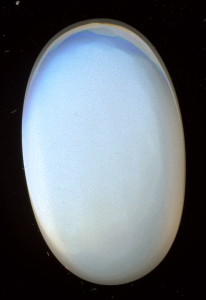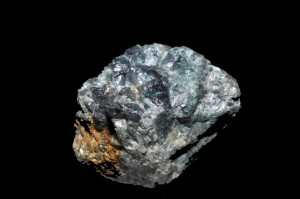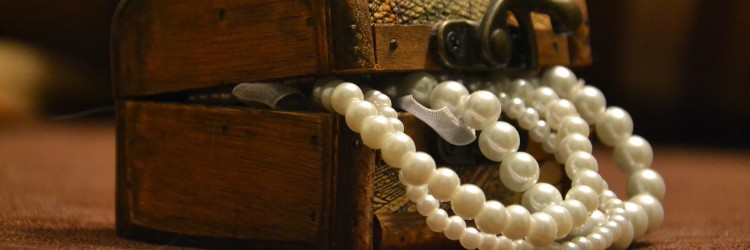The classic June birthstone is the white pearl, the only prized gem created organically, by a living creature. June is wedding month, and this birthstone is traditional because in its luminous beauty and self-sufficiency—it needs no fancy faceting—it represents purity and oneness of the body and mind. Often it is worn by brides, regardless of their birth date or wedding date.
One of the tests of a fine pearl is that you should be able to see yourself reflected in it. Few gifts are as treasured as a string of Grade AAA pearls, and few jewelry items are as wearable on every occasion as a pair of fine pearl earrings on 14-karat gold studs. I received my first pearl studs in the 1970s, and with good care, they are still beautiful.

June has two more birthstone alternatives. For astrological reasons, the moonstone is one of the two. Because our calendar months no longer line up with the Sun’s passage through the zodiac signs, those born in the first three weeks of June are born under the zodiac sign Gemini, the Twins; those in the final week of June under Cancer, the Crab. The sea-dwelling Crab is linked with the pearl, and some authorities say that only those born in the final third of June, under the sign of Cancer, can claim pearl as their birthstone. June-born Geminis are assigned the semi-precious moonstone, translucent silvery white with electric-blue flashes. The mercurial nature of Gemini and the blue flame of the moonstone have been likened for centuries. Frequently mined in the mountains of India and Sri Lanka, the better the moonstone the more blue it has, and the color matches it with Gemini, an air sign.
Alexandrite, June’s “Modern” Stone

Because of confusion over who should wear the pearl—and one can argue that both the pearl and the moonstone represent the Moon, the planet ruling Cancer—June’s modern birthstone, assigned in 1952 and covering both zodiac signs, is alexandrite, not as well known as it should be. This spectacular color-shifting gem in its natural form is rare and expensive and rarely larger than three carats. In daylight, the alexandrite turns from red-violet to seafoam green, and back to red-violet under electric light.
Most alexandrite currently sold is man-made and therefore not prohibitively expensive. June birthstone displays in department stores and jewelry stores are almost always of man-made, laboratory-grown stones (purplish-colored in the jewelry case), and in sunlight they perform the mesmerizing color change. If the purple stone does not change to green, you have a “simulated” alexandrite and its power is minimal.
Because laboratory-grown and natural alexandrites are chemically and physically identical, metaphysical authority Melody, author of Love is in the Earth, says they both function the same way. Alexandrite’s powers have nothing to do with purity and June weddings. According to Melody, alexandrite in crystal form can return you to the origin of time. If you want to feel reborn or change your world, covet and save for this stone. It’s also for centering and alignment. Unlike other birthstones, the Bible and ancient texts do not mention alexandrite, which is why we rely for now on channeled information. Melody writes that, metaphysically, alexandrite is a Scorpio stone. That might or might not be correct.
Isidore Kozminsky, author of the two-volume Magic and Science of Jewels and Stones, insists this is a stone for Aquarius because it was discovered only recently—some say in the 1820s, and others say later—as we approach the Aquarian Age.
Regardless of controversy, birthstone lore now holds that it’s the gem for all born in June. The name comes from Alexander, a Russian prince, because, legend says, the stone was first found in Russia on his birthday.
Powers of the Moonstone and Pearl
Moonstone attracts attention and affection. Put a moonstone on your key ring or other item you carry often if intending to capture someone’s attention. But if you wear moonstone all the time, it will cease to work. It’s considered feminine and receptive, like the moon and moonlight, and men who would not wear pearls can wear moonstone to get in touch with their feminine side.
A legend spread by an 1868 detective novel, The Moonstone by Wilkie Collins, says the moonstone is sinister and attracts bad luck. But Collins confused the moonstone with the opal, which for several reasons, including its chaotic internal structure, is hard to wear comfortably unless you are born in October or have Scorpio prominent in your birth chart. Opal is gorgeous but it is not for everybody. The young in particular should not wear opal. Moonstone can substitute.
Wear pearls to focus on tasks and business. Natural pearls have the most power, but there are no natural pearls circulating unless they are more than a century old. Pearls are the softest of the precious gems, age poorly, and yellow and go dull if repeatedly assaulted with chemicals such as hairspray or perfume. After wearing pearls, use a cloth to wipe them clean of body oils and store them where they cannot scratch each other or be scraped by other jewelry. You want to keep that mirrored surface! Because they are such pure and organic products, they require “clearing” or refreshing to maintain their spiritual attributes. Refresh them by taking them out on a cloth or a plate into the light of the full moon. A single loose pearl thrown into a river is a sacrificial act that is said to bring money.
Do “baroque” and “potato-shaped” pearls work as well as the round ones? From experience I can tell you they are fun to wear, but beyond that do not seem to enhance focus or productivity. Like pearls, they will enforce ladylike behavior. Wear them when you need an aura of intelligence and class.
Some New Agers and vegans refuse to wear pearls because oysters die during the harvesting of pearls, when their shells are pried open. For this reason, some believe every pearl carries bad karma, and nothing could be worse for your karma than wearing a whole string of them. On the brighter side, wear pearls or a pearl to win the favors of superstar goddesses such as Diana and Freya. Hindu astrologers advise setting a pearl in silver and wearing it on Mondays (Moon days) in emotionally turbulent times.
So, June-born readers, take your pick: alexandrite, moonstone, or pearl.
